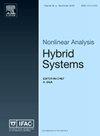一类有限标记马尔可夫系统的可检测性概念
IF 3.7
2区 计算机科学
Q2 AUTOMATION & CONTROL SYSTEMS
引用次数: 0
摘要
本文研究了时间概率条件下的状态估计问题。参考模型,即标记的时间概率自动机,用于此目的,并根据迄今为止收集的一系列观测结果及其相关时间戳定义后验概率向量。假定所考虑的系统的可观察语言是活的。本文的主要贡献是介绍和描述了时间随机系统的一些基本可探测性概念:(i)事件可探测性,这意味着系统在每次新观测的时间瞬间变得可探测,但在两次观测之间可能失去可探测性;(ii)无声可探测性,这意味着系统在任意大的持续时间内没有收集到观测时变得可探测。本文还研究了可探测性的放宽概念:首先,假设给定一个阈值,观察到的时间序列导致状态精确重构的先验概率大于或等于该阈值;第二,用对由多个状态组成的类的估计取代对单个状态的估计。本文章由计算机程序翻译,如有差异,请以英文原文为准。
Detectability notions for a class of finite labeled Markovian systems
This paper is about state estimation in a timed probabilistic setting. A reference model, namely a labeled timed probabilistic automaton, is used for this purpose and an a posteriori probability vector is defined based on a sequence of observations and their associated time stamps that have been collected thus far. The observable language of the considered system is assumed to be live. The main contribution of the paper is to introduce and characterize some basic detectability notions for timed stochastic systems: (i) event detectability, which implies that the system becomes detectable at the time instant of each new observation but may lose the detectability property between two observations, and (ii) silent detectability, which implies that the system becomes detectable when no observation is collected within an arbitrary large duration. Relaxed notions of detectability are also studied: first, assuming that, given a threshold, the a priori probability that an observed timed sequence leads to an exact reconstruction of the state, is larger than or equal to that threshold; second, by replacing the estimation of single states by the estimation of classes formed by several states.
求助全文
通过发布文献求助,成功后即可免费获取论文全文。
去求助
来源期刊

Nonlinear Analysis-Hybrid Systems
AUTOMATION & CONTROL SYSTEMS-MATHEMATICS, APPLIED
CiteScore
8.30
自引率
9.50%
发文量
65
审稿时长
>12 weeks
期刊介绍:
Nonlinear Analysis: Hybrid Systems welcomes all important research and expository papers in any discipline. Papers that are principally concerned with the theory of hybrid systems should contain significant results indicating relevant applications. Papers that emphasize applications should consist of important real world models and illuminating techniques. Papers that interrelate various aspects of hybrid systems will be most welcome.
 求助内容:
求助内容: 应助结果提醒方式:
应助结果提醒方式:


